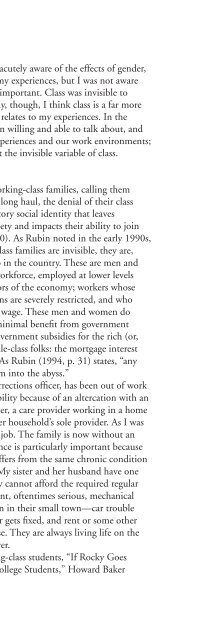WINTER 2012 - National Association of Schools of Public Affairs and ...
WINTER 2012 - National Association of Schools of Public Affairs and ...
WINTER 2012 - National Association of Schools of Public Affairs and ...
You also want an ePaper? Increase the reach of your titles
YUMPU automatically turns print PDFs into web optimized ePapers that Google loves.
Techniques in Teaching Statistics<br />
likely very interested in the subject <strong>of</strong> our study. Thus, we were willing to accept<br />
the self-selection bias that may result.<br />
To begin identifying our sample, we selected the top 10 graduate schools<br />
between 2003 <strong>and</strong> 2005, as ranked by U.S. News <strong>and</strong> World Report (2005, 2006),<br />
in six social science disciplines containing practitioner-oriented master’s degree<br />
programs: business administration, criminology, higher education administration,<br />
public affairs, public health, <strong>and</strong> social work. While these six social science<br />
disciplines have many differences, discussions with instructors teaching statistics<br />
in these types <strong>of</strong> programs suggest there are commonalities in the challenges<br />
instructors face in teaching statistics to students across such programs. We<br />
acknowledge that a top ranking does not necessarily ensure high-quality teaching<br />
as well. This listing was used as a method for identifying a manageable sampling<br />
frame that would contain participants meeting our desired group characteristics.<br />
Using the top-ranked schools in these six disciplines resulted in a list <strong>of</strong> 66<br />
schools. From these 66 schools, we contacted a school representative to identify<br />
who teaches statistics as well as e-mail contact information for such instructors.<br />
We removed 11 schools from the original list <strong>of</strong> 66 because they either (a) did<br />
not have a practitioner-oriented master’s degree program; (b) did not require<br />
statistics as part <strong>of</strong> the curriculum; or (c) faculty members teaching statistics<br />
were unavailable because <strong>of</strong> sabbatical, illness, or other pr<strong>of</strong>essional duties. Of<br />
the remaining 55 schools, 34 representing each <strong>of</strong> the six disciplines originally<br />
selected responded with the names <strong>and</strong> contact information for statistics<br />
instructors in their departments. From these 34 schools, we compiled a list <strong>of</strong><br />
77 eligible statistics instructors <strong>and</strong> contacted each one via e-mail, informing<br />
the instructors about our project <strong>and</strong> asking them to participate. Of the 77<br />
instructors contacted, 25 instructors were willing to participate.<br />
The U.S. Department <strong>of</strong> Education’s <strong>National</strong> Center for Education<br />
Statistics defines “new faculty” as those in their first seven years <strong>of</strong> academic<br />
employment (U.S. Department <strong>of</strong> Education, 1998). Based on this definition,<br />
we define experienced instructors as those who have been teaching statistics for 8<br />
or more years. After we identified “experienced” respondents, 18 instructors from<br />
14 schools in five social science disciplines remained in our sample.<br />
Once data collection began, <strong>of</strong> the 18 instructors in our sample, 13 actually<br />
participated in the first stage (generating ideas in response to the four questions),<br />
8 in the second stage (clustering the ideas generated from all participants), <strong>and</strong> 7<br />
in the third stage (prioritizing the clusters).<br />
Phase III: Data Collection<br />
Because our sample contained individuals located in a variety <strong>of</strong> time<br />
zones throughout the United States, individual interviews <strong>and</strong>/or focus groups,<br />
although feasible, were extremely difficult. Using an electronic Delphi method,<br />
we followed Rohrbaugh (2000) <strong>and</strong> Martinez-Moyano <strong>and</strong> Richardson (2002)<br />
Journal <strong>of</strong> <strong>Public</strong> <strong>Affairs</strong> Education 117

















